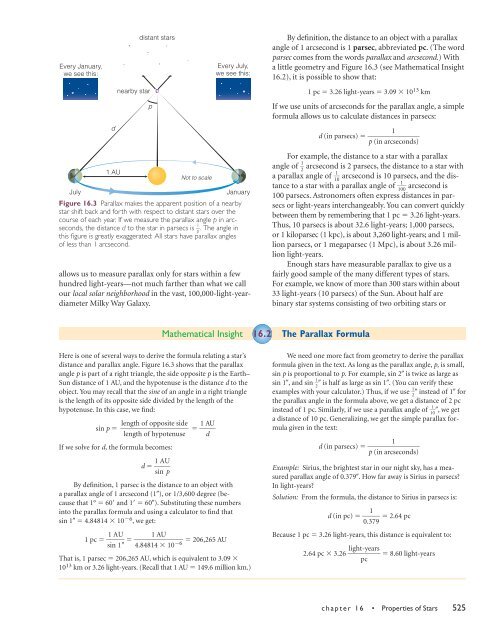Chapter 16--Properties of Stars
Chapter 16--Properties of Stars
Chapter 16--Properties of Stars
You also want an ePaper? Increase the reach of your titles
YUMPU automatically turns print PDFs into web optimized ePapers that Google loves.
Every January,<br />
we see this:<br />
July<br />
d<br />
1 AU<br />
nearby star<br />
distant stars<br />
Figure <strong>16</strong>.3 Parallax makes the apparent position <strong>of</strong> a nearby<br />
star shift back and forth with respect to distant stars over the<br />
course <strong>of</strong> each year. If we measure the parallax angle p in arc-<br />
seconds, the distance d to the star in parsecs is 1<br />
p<br />
. The angle in<br />
this figure is greatly exaggerated: All stars have parallax angles<br />
<strong>of</strong> less than 1 arcsecond.<br />
p<br />
Not to scale<br />
Every July,<br />
we see this:<br />
January<br />
allows us to measure parallax only for stars within a few<br />
hundred light-years—not much farther than what we call<br />
our local solar neighborhood in the vast, 100,000-light-yeardiameter<br />
Milky Way Galaxy.<br />
Here is one <strong>of</strong> several ways to derive the formula relating a star’s<br />
distance and parallax angle. Figure <strong>16</strong>.3 shows that the parallax<br />
angle p is part <strong>of</strong> a right triangle, the side opposite p is the Earth–<br />
Sun distance <strong>of</strong> 1 AU, and the hypotenuse is the distance d to the<br />
object. You may recall that the sine <strong>of</strong> an angle in a right triangle<br />
is the length <strong>of</strong> its opposite side divided by the length <strong>of</strong> the<br />
hypotenuse. In this case, we find:<br />
sin p 1AU<br />
<br />
d<br />
If we solve for d, the formula becomes:<br />
d 1 AU<br />
<br />
sin p<br />
By definition, 1 parsec is the distance to an object with<br />
a parallax angle <strong>of</strong> 1 arcsecond (1), or 1/3,600 degree (because<br />
that 1° 60 and <strong>16</strong>0). Substituting these numbers<br />
into the parallax formula and using a calculator to find that<br />
sin 14.84814 106 ,we get:<br />
1 AU<br />
1 AU<br />
1 pc <br />
sin<br />
1<br />
4.84814<br />
106 206,265 AU<br />
That is, 1 parsec 206,265 AU, which is equivalent to 3.09 <br />
1013 length <strong>of</strong> opposite side<br />
<br />
length <strong>of</strong> hypotenuse<br />
km or 3.26 light-years. (Recall that 1 AU 149.6 million km.)<br />
By definition, the distance to an object with a parallax<br />
angle <strong>of</strong> 1 arcsecond is 1 parsec,abbreviated pc.(The word<br />
parsec comes from the words parallax and arcsecond.) With<br />
a little geometry and Figure <strong>16</strong>.3 (see Mathematical Insight<br />
<strong>16</strong>.2), it is possible to show that:<br />
1 pc 3.26 light-years 3.09 10 13 km<br />
If we use units <strong>of</strong> arcseconds for the parallax angle, a simple<br />
formula allows us to calculate distances in parsecs:<br />
1<br />
d (in parsecs) <br />
p (in arcseconds)<br />
<br />
For example, the distance to a star with a parallax<br />
angle <strong>of</strong> 1<br />
<br />
2 arcsecond is 2 parsecs, the distance to a star with<br />
1<br />
a parallax angle <strong>of</strong> 10<br />
arcsecond is 10 parsecs, and the dis-<br />
1<br />
tance to a star with a parallax angle <strong>of</strong> 100<br />
arcsecond is<br />
100 parsecs. Astronomers <strong>of</strong>ten express distances in parsecs<br />
or light-years interchangeably. You can convert quickly<br />
between them by remembering that 1 pc 3.26 light-years.<br />
Thus, 10 parsecs is about 32.6 light-years; 1,000 parsecs,<br />
or 1 kiloparsec (1 kpc), is about 3,260 light-years; and 1 million<br />
parsecs, or 1 megaparsec (1 Mpc), is about 3.26 million<br />
light-years.<br />
Enough stars have measurable parallax to give us a<br />
fairly good sample <strong>of</strong> the many different types <strong>of</strong> stars.<br />
For example, we know <strong>of</strong> more than 300 stars within about<br />
33 light-years (10 parsecs) <strong>of</strong> the Sun. About half are<br />
binary star systems consisting <strong>of</strong> two orbiting stars or<br />
Mathematical Insight <strong>16</strong>.2 The Parallax Formula<br />
We need one more fact from geometry to derive the parallax<br />
formula given in the text. As long as the parallax angle, p, is small,<br />
sin p is proportional to p. For example, sin 2 is twice as large as<br />
sin 1, and sin 1 2 is half as large as sin 1.(You can verify these<br />
examples with your calculator.) Thus, if we use 1 2 instead <strong>of</strong> 1 for<br />
the parallax angle in the formula above, we get a distance <strong>of</strong> 2 pc<br />
1<br />
instead <strong>of</strong> 1 pc. Similarly, if we use a parallax angle <strong>of</strong> ,we 10<br />
get<br />
a distance <strong>of</strong> 10 pc. Generalizing, we get the simple parallax formula<br />
given in the text:<br />
1<br />
d (in parsecs) <br />
p (in arcseconds)<br />
<br />
Example: Sirius, the brightest star in our night sky, has a measured<br />
parallax angle <strong>of</strong> 0.379.How far away is Sirius in parsecs?<br />
In light-years?<br />
Solution: From the formula, the distance to Sirius in parsecs is:<br />
1<br />
d (in pc) 2.64 pc<br />
0.379<br />
Because 1 pc 3.26 light-years, this distance is equivalent to:<br />
2.64 pc 3.26 light-years<br />
8.60 light-years<br />
pc<br />
chapter <strong>16</strong> • <strong>Properties</strong> <strong>of</strong> <strong>Stars</strong> 525
















